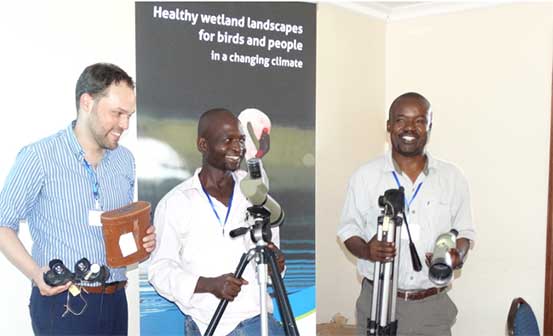
The National and county governments have been urged to urgently formulate a legislative act that will protect the country’s wetlands which are now facing extinction due to increased human activities.
Safeguarding and restoring wetlands is urgent and vital for water security, biodiversity, climate regulation, sustainable development and human health. Speaking during the 50th International Water Bird Count census in Yala swamp, Siaya County, Wetlands International programme manager, Julie Mulonga said there is need to safeguard wetlands for people and nature through the conservation of birds and the biodiversity of the Lake Victoria basin.
“This is not a one off event and as such we would like to reinforce the importance of bird count all over the country in the identified Important Bird Areas or the RAMSAR sites. It is important to note that human activities like farming around the wetlands destroy these ecosystems, hence we encourage sustainable individual livelihood in a changing climate,” said Julie.
During the exercise over 30 species of birds like the; yellow way tail, swallows ,barn, pied ,weavers, whiskered turns ,little grate ,black headed gunlock ,heron ,sacred, spur-plover ,black winged stilt among others were counted in Dhogoye and Sanda beach in Yala swamp. The event saw more than15 community members trained on bird count and two telescopes and 10 binoculars donated to Nature Kenya by the team.
“We believe in the bird census because it helps in their population estimation, monitoring changes in their distribution and identifying their flyways,” she added, revealing that most of the birds migrate from Europe to Kenya and vice versa in six months allowing the bird counts to be done in the month of January and July.
Ward Hagemeijer head of ecosystems at Wetlands International in Netherlands said that there is need to train more specialized people on counting of the birds. He however encouraged a regular count to enable proper documentation of the statistics and estimates.
“We are already working on a project to look into some sites in the face of climate. Earlier this year Wetlands International launched a year-long campaign “Let’s make it count” in partnership with its national and international IWC partners, volunteers and governments. With this campaign they aim to raise the bar and increase the number of important wetland sites covered by the annual count, and ensure the latest and most up-to-date information about waterbirds is available to support conservation action worldwide.
Kenya is among the best countries in Africa when it comes to bird census though there is still need for more capacities for widespread,” he added. It is worth noting that this data can be used in relation to land use changes and rainfall variation, to determine if there is any change in their habitat in the long run.
“The current data is still unripe because of existing bias of counts being more skewed to human settlement areas resulting in less coverage in remote areas. Also some of the observers are still learning bird calls/sounds since they are unable to identify and record all the birds,” he added.
The IWC was launched 50 years ago and has become one of the most valuable biodiversity monitoring programmes in the world, supporting conservation and management of wetlands and waterbirds in all the world’s flyways.
 The Standard Group Plc is a multi-media organization with investments in media
platforms spanning newspaper print operations, television, radio broadcasting,
digital and online services. The Standard Group is recognized as a leading
multi-media house in Kenya with a key influence in matters of national and
international interest.
The Standard Group Plc is a multi-media organization with investments in media
platforms spanning newspaper print operations, television, radio broadcasting,
digital and online services. The Standard Group is recognized as a leading
multi-media house in Kenya with a key influence in matters of national and
international interest.
 The Standard Group Plc is a multi-media organization with investments in media
platforms spanning newspaper print operations, television, radio broadcasting,
digital and online services. The Standard Group is recognized as a leading
multi-media house in Kenya with a key influence in matters of national and
international interest.
The Standard Group Plc is a multi-media organization with investments in media
platforms spanning newspaper print operations, television, radio broadcasting,
digital and online services. The Standard Group is recognized as a leading
multi-media house in Kenya with a key influence in matters of national and
international interest.









